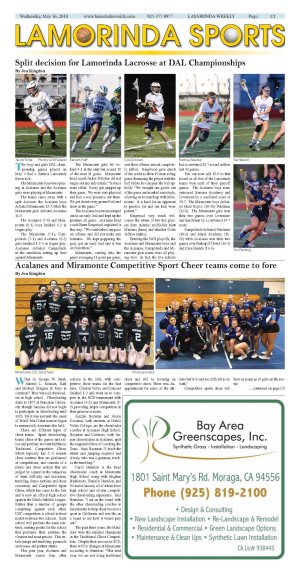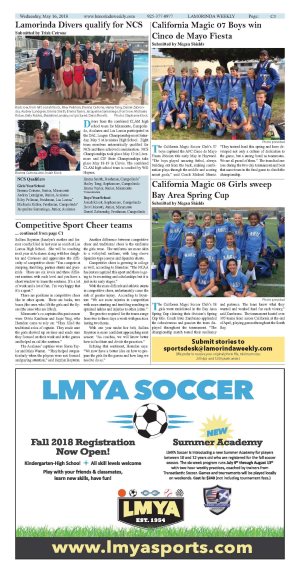| | Published May 16th, 2018
| Acalanes and Miramonte Competitive Sport Cheer teams come to fore
| | | By Jon Kingdon |  | | Miramonte CSC Stunt Team Photo provided |
What do George W. Bush, Samuel L. Jackson, Kirk and Michael Douglas all have in common? They were all cheerleaders in high school. Cheerleading dates to 1877 at Princeton University though females did not begin to participate in cheerleading until 1923. Yet it was not until the onset of World War II that women began to numerically dominate this field.
 There are different types of cheer teams: Spirit cheerleading teams cheer at the games and rallies and perform at event halftimes; Traditional Competitive Cheer, which typically has 2 1/2 minute cheer routines that are performed at competitions, and consists of a music and cheer section that are judged by a panel in the categories of stunt difficulty and execution, tumbling, dance motions and cheer execution; and Competitive Sport Cheer, which has come to the fore and is now an official high school sport in the Diablo Athletic League. Rather than a number of groups competing against each other, CSC competition is a head-to-head match between two schools. Each school will perform the same routines, earning points for the school that performs their routines the cleanest and most precise. This entails jumps and tumbling, pyramids and tosses and partner stunts.
There are different types of cheer teams: Spirit cheerleading teams cheer at the games and rallies and perform at event halftimes; Traditional Competitive Cheer, which typically has 2 1/2 minute cheer routines that are performed at competitions, and consists of a music and cheer section that are judged by a panel in the categories of stunt difficulty and execution, tumbling, dance motions and cheer execution; and Competitive Sport Cheer, which has come to the fore and is now an official high school sport in the Diablo Athletic League. Rather than a number of groups competing against each other, CSC competition is a head-to-head match between two schools. Each school will perform the same routines, earning points for the school that performs their routines the cleanest and most precise. This entails jumps and tumbling, pyramids and tosses and partner stunts.
 This past year, Acalanes and Miramonte joined four other schools in the DAL with competitive cheer teams for the first time. Clayton Valley and Concord finished 1-2 and went on to compete in the NCS tournament with Acalanes (4-2) and Miramonte (1-5) providing ample competition in their premier seasons.
This past year, Acalanes and Miramonte joined four other schools in the DAL with competitive cheer teams for the first time. Clayton Valley and Concord finished 1-2 and went on to compete in the NCS tournament with Acalanes (4-2) and Miramonte (1-5) providing ample competition in their premier seasons.
 Jazzlyn Boynton and Alexis Caviness, both students at Diablo Valley College, are the cheerleader coaches at Acalanes High School. Boynton and Caviness, both former cheerleaders at Acalanes, split the responsibilities of coaching the Dons. Says Boynton: "I teach the stunts and jumping required and Alexis, who was a gymnast, teaches the tumbling."
Jazzlyn Boynton and Alexis Caviness, both students at Diablo Valley College, are the cheerleader coaches at Acalanes High School. Boynton and Caviness, both former cheerleaders at Acalanes, split the responsibilities of coaching the Dons. Says Boynton: "I teach the stunts and jumping required and Alexis, who was a gymnast, teaches the tumbling."
 Carol Herndon is the head cheerleader coach at Miramonte High School along with Meghan Hashimoto, Danielle Herndon, and Victoria Carozza, all of whom have high school and all-star competitive cheerleading experience. Said Herndon: "I sat on the board with the other cheerleading coaches in Sacramento to help cheer become a sport in California and was the on a board to see how it would play out."
Carol Herndon is the head cheerleader coach at Miramonte High School along with Meghan Hashimoto, Danielle Herndon, and Victoria Carozza, all of whom have high school and all-star competitive cheerleading experience. Said Herndon: "I sat on the board with the other cheerleading coaches in Sacramento to help cheer become a sport in California and was the on a board to see how it would play out."
 The past three years, the Matadors were the national champions in the Traditional Cheer Competition. Despite their success in TCC, there will be changes at Miramonte according to Herndon: "This next year, we are not doing traditional cheer and will be focusing on competitive cheer. There was disappointment for some of the athletes but it is just too difficult to do both."
The past three years, the Matadors were the national champions in the Traditional Cheer Competition. Despite their success in TCC, there will be changes at Miramonte according to Herndon: "This next year, we are not doing traditional cheer and will be focusing on competitive cheer. There was disappointment for some of the athletes but it is just too difficult to do both."
 Competitive sports cheer will have as many as 30 girls on the roster. Sallina Boynton (Jazzlyn's mother and former coach) filled in last year as coach at Las Lomas High School. She will be coaching next year at Acalanes along with her daughter and Caviness and appreciates the difficulty of competitive cheer: "You compete at jumping, tumbling, partner stunts and pyramids There are six levels and three different routines with each level and you have a short window to learn the routines. It's a lot of work and a lot of fun. I'm very happy that it's a sport."
Competitive sports cheer will have as many as 30 girls on the roster. Sallina Boynton (Jazzlyn's mother and former coach) filled in last year as coach at Las Lomas High School. She will be coaching next year at Acalanes along with her daughter and Caviness and appreciates the difficulty of competitive cheer: "You compete at jumping, tumbling, partner stunts and pyramids There are six levels and three different routines with each level and you have a short window to learn the routines. It's a lot of work and a lot of fun. I'm very happy that it's a sport."
 There are positions in competitive cheer like in other sports. There are backs, two bases (the ones who lift the girls and the flyers (the ones who are lifted).
There are positions in competitive cheer like in other sports. There are backs, two bases (the ones who lift the girls and the flyers (the ones who are lifted).
 Miramonte's co-captains this past season were Olivia Kaufman and Jaqui Yuqi, who Herndon came to rely on: "They filled the traditional roles of captain. They made sure the girls showed up on time and made sure they focused on their work and at the games and helped us call the routines."
Miramonte's co-captains this past season were Olivia Kaufman and Jaqui Yuqi, who Herndon came to rely on: "They filled the traditional roles of captain. They made sure the girls showed up on time and made sure they focused on their work and at the games and helped us call the routines."
 The Acalanes' captains were Sierra Taylor and Maia Warren. "They helped out particularly when the players were not focused and paying attention," said Jazzlyn Boynton.
The Acalanes' captains were Sierra Taylor and Maia Warren. "They helped out particularly when the players were not focused and paying attention," said Jazzlyn Boynton.
 Another difference between competitive cheer and traditional cheer is the uniforms the girls wear. The uniforms are more akin to a volleyball uniform, with long sleeve Spandex-type jerseys and Spandex shorts.
Another difference between competitive cheer and traditional cheer is the uniforms the girls wear. The uniforms are more akin to a volleyball uniform, with long sleeve Spandex-type jerseys and Spandex shorts.
 Competitive cheer is growing in college as well, according to Herndon: "The NCAA has just recognized this sport and there is going to be recruiting and scholarships but it is just in its early stages."
Competitive cheer is growing in college as well, according to Herndon: "The NCAA has just recognized this sport and there is going to be recruiting and scholarships but it is just in its early stages."
 With the more difficult and athletic stunts in competitive cheer, unfortunately come the risk of greater injury. According to Boynton: "We see more injuries in competition with more stunting and tumbling resulting in sprained ankles and injuries to other joints."
With the more difficult and athletic stunts in competitive cheer, unfortunately come the risk of greater injury. According to Boynton: "We see more injuries in competition with more stunting and tumbling resulting in sprained ankles and injuries to other joints."
 The practice required for the teams range from two to three days a week with practices lasting two hours.
The practice required for the teams range from two to three days a week with practices lasting two hours.
 With one year under her belt, Sallina Boynton is more confident approaching next season: "As coaches, we will know better how to facilitate and divide the practices."
With one year under her belt, Sallina Boynton is more confident approaching next season: "As coaches, we will know better how to facilitate and divide the practices."
 Echoing that sentiment, Herndon says: "We now have a better idea on how to prepare the girls for the games and how long we need to do so."
Echoing that sentiment, Herndon says: "We now have a better idea on how to prepare the girls for the games and how long we need to do so."

|
 | | | | | | | | | | | | | |





